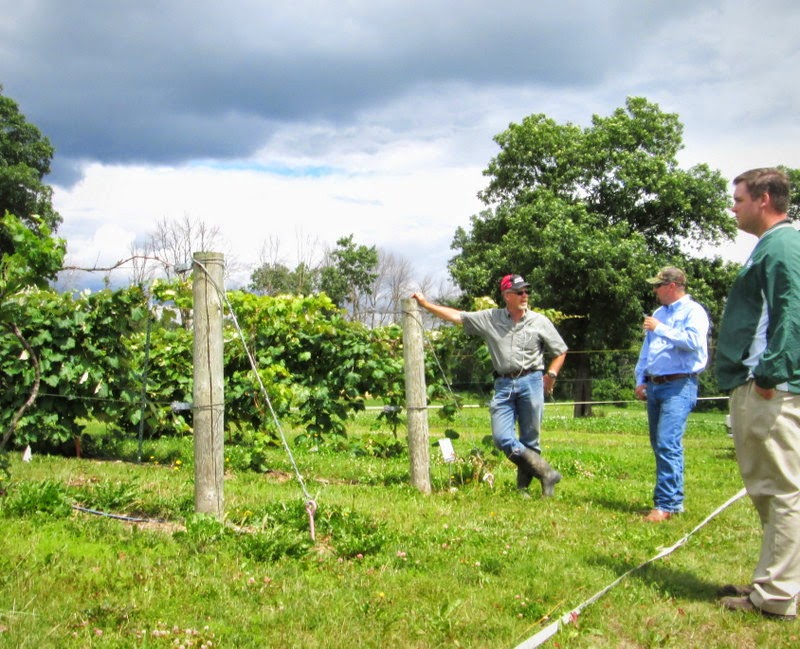So the corn at the NCRS was planted later than normal due to uncornish spring weather. And it's been cool this summer besides. So I was pleased to see some corn tassels finally emerged last Wednesday when I stopped by in between the growth conference sessions. In a good year you can see the start of tassels around the 4th of July. Unfortunately some corn is still only chest high though.
Brian had some work to do making foliar fertilizer applications to Concord grapes. He was using the backpack air blast sprayer. It does a great job of leaf coverage.
And we were were happy to have a couple of visitors. It was Reid and Brady. I was just with them in Louisiana and they were so enthralled with research down there that they came by to catch some top notch research at the NCRS. Below we see Brian giving them the low down on what's up at the NCRS.
Then on Friday I made a return visit to the NCRS. I wanted to spend some time in the field with two of the college interns: Kelly and Jimmy. They are working in specialty/horticulture crops with Dr. Brian. I wanted them to show me around and see some of what they have learned. Here we are looking at some of the vegetable plots on Farm 12 that will be on the Research Field Days. Behind is the fast growing celery that I showed being planted in an earlier blog post. Won't be long until we will need some cheese spread to go along with it.
Each of the interns has a special project to oversee. Jimmy is testing some magnesium foliar treatments on potatoes. Which of the treatments will be most effective? Only Jimmy knows.
And Kelly is going to be measuring the effects of different fertilizers on fruit quality of Concord grapes. These have a ways to go but are in good hands. (OK that pun analogy sounds pretty lame. But they really are.)
I don't think I have ever revealed the unfortunate incident that occurred in the apple orchard last winter. But I think enough time has passed that the truth can now be told. It seems that the snow got so deep last winter, that ravenous rabbits were able to reach up beyond the tree guards and eat the bark which essentially girdled the trees. They did this under the cover of night and was not a factor with normal snowfall the previous winter. There was an epidemic of this in Michigan. So the tops of the trees would have died anyway, and it was necessary to remove the part of the tree above the damage zone. This would promote new stem growth. New growth was rapid with the removal of apical dominance. Then it is necessary to set one stem as the new leader and guide it to grow straight while training the side branches to grow....well, sideways to be attached to the wire in the future. Clothespins are being used to direct growth. Neat trick. Below you can see how it works. See the branch beneath the pin is being pushed out, and after time, will become thick and can be attached to the guidewire.
Below we see Kelly attaching clothespins. Both she and Jimmy said that they have learned a lot about apples working on this recovery effort. This rabbit invasion has set the research behind a few years, but the trees will fully recover.
The problem though, is with high density planting, there are over a couple thousand trees to be pinned in the orchard. They also need to be re-checked from time to time as well.
So to answer the question: there is a big fence around the orchard. But that is for deer. And there were no deer that got in. But rabbits got in and new prevention efforts will have to be implemented. But they are recovering nicely now with the care by Jimmy and Kelly.








